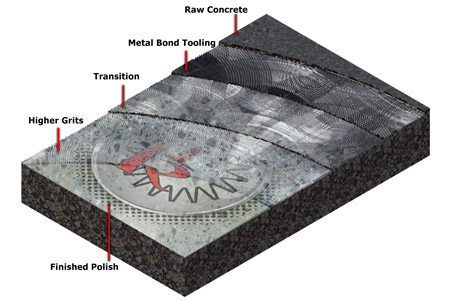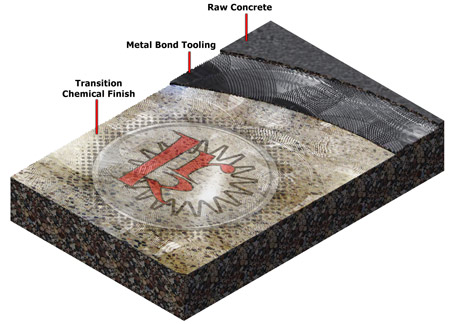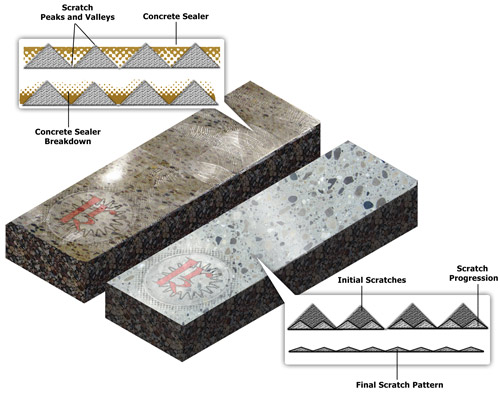The Mechanical Process

When polished concrete is discussed, it is important to understand its definition. Polished concrete is a process that takes abrasives (diamonds) and mechanically places scratches in the concrete. This scratching process continues, using a finer grit abrasives to remove and replace the scratches with a smaller and smaller micro scratches.
The objective is to refine the floor and take away the small scratches so that you see a reflection in the floor. This process is used with a chemical that helps densify the floor to its maximum hardness. This process can be achieved with older concrete, new concrete and/or coated concrete. The process is always the same in terms of scratches to the floor and refining the concrete into a harder, denser product.
The mechanically polished concrete process is considered to be the maximum refinement method and is the best long-term solution of polished concrete.
With the floor at its maximum refinement, the peaks of the scratches cannot break off and distort the finish of the slab. The process will also reduce dirt and debris from getting trapped between scratches, and makes it much easier to clean the floor – and keep it clean.
The Topical Process

The opposite side of this discussion is a topical concrete polish.
The method is relatively the same as the mechanically polished floor, but the course of action is shorter and it leaves the floor at less than maximum refinement.
Most of the time the topically processed progression ends at 200- or 400-grit step. These grits leave peaks on the top of the scratches that have zero lateral support. A topical sealer is added and rushes into the gaps left by the scratching process. As the sealer settles and dries, it gives the appearance of a full process slab and is referred to as “polished concrete.”
However, as the floor is used and ages, the sealer does not possess the strength of the concrete and quickly starts to fail at the micro-scale level. As a result, this distorts the finish and the floor develops traffic patterns and will start to dust.
Once the floor has been compromised, it will start to break down and be topically unstable. Often times this type of floor has to be recoated with a sealer, which results in build coats along edges and a distortion in shine, due to the different levels and angles of reflection.
Why Opt For A Mechanical Polish?
Many people in the industry are selling a topical finish to concrete as “polished concrete”. The definition alone gives false expectations.
When you truly mechanically process concrete the diamond tools put a series of scratches (peaks and valleys) in the top layer of the concrete. This process continues with finer and finer grit diamonds. The end result is a series of micro scratches that are so small and so close to one another that the mass of concrete as a whole has reflection characteristics. The smooth surface with precise-like, uniform scratches enables light to bounce off the surface, giving a clean, crisp shine because the angle of reflection is almost flat. This process also greatly increases the slip-resistant and the wear factors of the floor.
The mechanical process, with the use of a quality densifier, greatly increases the stain- resistance performance of the floor as well. With the peaks and valleys so small, the floor will hold up longer over time because the wear layer is concrete itself and not a topical coating.
With this method of processed concrete the peaks have less of a chance to break off because they are so small. At the same time, a mechanically polished floor will not hold as much dirt, due to the shallowness of the valleys between the microscopic peaks.
This process is more expensive up front – but a much more sustainable floor for the long run, and is by far the best choice for the knowledgeable contractor.

Why Opt For A Topical Polish?
This process is a much cheaper alternative to the mechanical process. The “topical polish” is exactly the same thing as putting on a coating. This method can be done with a burnisher, a floor scrubber and even a swing machine.
The topical process can often be similar to the mechanical process – except for the fact that the contractor stops short of full refinement. A sealer or post-polish guard product would then be applied to the surface, filling in the peaks and valleys. This gives a polished appearance, but will have to be maintained and recoated often to give the same look.
These floors traditionally do not have the same clean, crisp appearance as mechanically polished floors because the angle of reflection can be distorted. It will appear shiny because of the unified layer of dry solids left behind from the sealer or guard. This is NOT a floor that is long sustaining. The topcoat can wear very quickly and accelerate with the presence of heavy foot or wheel traffic. The wearing of the sealer also exposes the peaks and valleys, causing the microscopic peaks to break away and the valleys to hold more dirt.
The topical process is much cheaper up front, but much more expensive to maintain.




